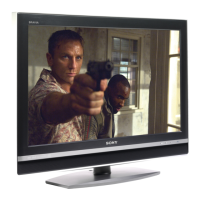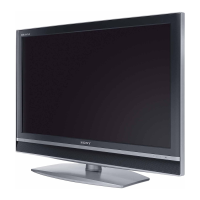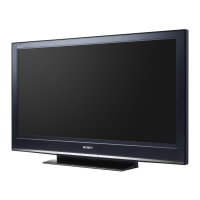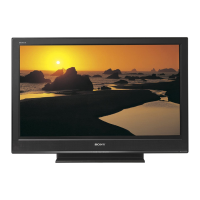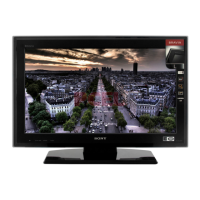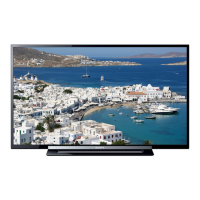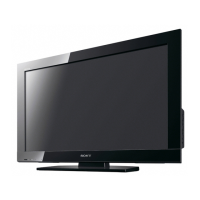
Do you have a question about the Sony bravia kdl-32v5500 and is the answer not in the manual?
Key safety guidelines for TV installation and usage.
Region-specific operational and rating information.
Initial checks and preparation before operating the TV.
Instructions for physically attaching the TV stand.
Guidance on connecting external broadcast and recording devices.
Safety instructions to prevent the TV from falling.
Instructions for organizing and bundling TV cables.
Steps for the initial configuration of the TV.
Critical safety precautions for installing the TV.
Ensuring proper airflow and safe use of the power cord.
Restrictions on where and how the TV should not be used.
Safety advice for broken TVs and child-related hazards.
Maintenance, cleaning, and battery precautions.
Overview of physical buttons and status lights on the TV.
Primary buttons on the remote for TV operation.
Buttons for navigating menus and selecting options.
Buttons for audio adjustment and media playback.
Buttons for program guides, lists, and scene modes.
Buttons for text, subtitles, and other features.
Buttons for audio, channel tuning, and HDMI sync.
Buttons dedicated to controlling connected devices.
Meaning of the TV's status indicator lights.
How to use the TV's built-in help system.
Powering up the TV and switching between digital/analogue.
Tuning channels and understanding on-screen information.
Using Teletext and related features.
Controlling picture display dimensions.
Navigating and viewing TV program information.
Scheduling and removing program reminders.
Adding, removing, and watching analogue favorite channels.
Managing digital favorite channels.
Types of equipment that can be connected to the TV.
Connecting AV devices like DVD players and camcorders.
Connecting audio systems and USB storage devices.
Connecting computers and network devices.
Choosing which connected device to display.
Using Twin Picture and Picture-in-Picture.
Supported formats and auto-start functionality.
Displaying photos as a digital picture frame.
Adjusting the time photos are displayed.
Using GPS data to show photo locations on a map.
How BRAVIA Sync controls connected HDMI devices.
Setup steps for HDMI control.
Buttons on the remote for operating external devices.
Setting up the remote to control other brands/devices.
Resolving issues during remote setup.
List of codes for various device manufacturers.
Steps to establish a network connection.
Accessing and playing media from network servers.
Customizing which servers appear on the Home Menu.
Diagnosing and resolving network connection problems.
Understanding the TV's main interface and navigation.
Managing software updates and accessing the manual.
Configuring time-based features and power saving modes.
Adjusting for ambient light and input-specific preferences.
Choosing preset picture quality modes.
Adjusting brightness, contrast, and colour.
Fine-tuning sharpness, noise reduction, and motion.
Adjusting black levels, gamma, and colour space.
Choosing preset sound profiles.
Adjusting volume, treble, bass, and balance.
Configuring immersive audio effects.
Selecting stereo or mono audio output.
Controlling picture aspect ratio and display area.
Optimizing PC display and manual adjustments.
Aspect ratios for PC and colour space configurations.
Configuring audio output methods.
USB auto start and quick start options.
Customizing input names and video jack settings.
Setting up BRAVIA Sync and managing HDMI devices.
Initial setup process and resetting TV to defaults.
Setting up analogue channels, favourites, and sorting.
Picture noise reduction and channel tuning presets.
Adjusting reception and signal strength.
Configuring subtitles and audio languages/types.
Scanning and organizing digital channels.
Customizing the screen display during radio playback.
Setting age restrictions and PIN codes for viewing.
Managing TV software and service updates.
Configuring network parameters for connectivity.
Verifying connection and managing network servers.
Detailed instructions for mounting the TV using a bracket.
Technical details on panel, TV system, and ports.
Detailed information on all TV connectors.
TV size, weight, and accessory information.
Supported resolutions and frequencies for PC input.
Resolving self-diagnosis codes and display problems.
Addressing problems with video, audio, and channel reception.
Troubleshooting network connection failures.
Resolving server access and file display problems.
Troubleshooting power, standby, and input selection problems.
Resolving problems with the remote and HDMI control functionality.
